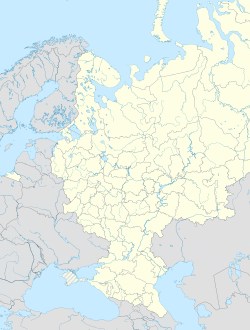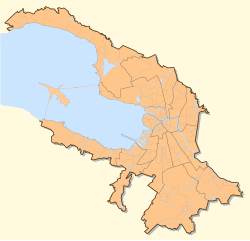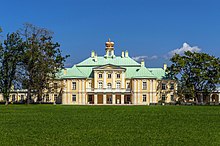Lomonosov
| city
Lomonosov
Ломоносов
|
||||||||||||||||||||||||||||||||||
|
||||||||||||||||||||||||||||||||||
|
||||||||||||||||||||||||||||||||||
| List of cities in Russia | ||||||||||||||||||||||||||||||||||
Lomonossow ( Russian Ломоносов ), until 1948 Oranienbaum , is an administratively part of Saint Petersburg ( Russia ) city. It is located 40 km west of the city center on the Neva Bay of the Baltic Sea and immediately south of the island of Kotlin in the Petrodvorets district . The city has an orange tree in its coat of arms .
Oranienbaum was granted city rights in 1780. It was an independent city until 1998, but then, along with other suburbs, it was placed under the municipal administration of Saint Petersburg. Lomonosov has 42,505 inhabitants (as of October 14, 2010).
The ensemble of castles, pavilions, a castle park and the historic old town was included in the list of world cultural and natural heritage of mankind by UNESCO in 1990.
history
founding
Oranienbaum was established in 1710 with the construction of the palace and park complex for Prince Menshikov , a close advisor to Peter the Great . He was the first governor general of Saint Petersburg. It is said that Menshikov named the settlement after the orange trees grown in the castle's orangery . In 1848 there were 6,344 German-speaking settlers in Oranienbaum.
“History of the German colonies in the Petersburg governorate according to P. von Köppen.
After Peter the Great built the fortress on the Neva on May 16, 1703, it was natural that he should try to encourage the influx of foreigners. The settlement of German residents in and around Petersburg began at the beginning of the 18th century.
In the first year of her reign, Catharina II declared in a manifesto issued on December 4, 1762 that every foreigner (with the exception of the Hebrews) was free to move to Russia and to settle here. Soon thereafter (on June 22, 1763) the monarch founded a Tutel law firm for the benefit of the immigrant foreign settlers, who were promised complete freedom of religion, their own jurisdiction in the colonies they had founded, and 30 years of exemption from taxes; In addition to the land they needed, they received advances and the assurance that they would not have to become soldiers. Under such circumstances it was natural to find people in Germany who liked to move to Russia, where they were welcomed with open arms.
As a result of ordinances which the Empress on Sept. 30th Issued in 1765, 110 colonist families were settled in the St. Petersburg government in that year, namely: [...] "
According to another version, the name Oranienbaum was chosen with a view to Oranienbaum in Anhalt-Dessau and Peter I's enthusiasm for the Orange people .
Palaces
The numerous palaces and parks of Oranienbaum served as summer residences for the imperial family and the nobility until 1917. Empress Catherine II (the Great) , who came from Germany, also had a summer residence there, the Chinese Palace. The inside and the outside are exquisitely beautiful. The palace buildings offer a very rare collection of craftsmanship from the 18th century, including Russian and Meissen porcelain , exquisite furniture and enamel work. Catherine the Great brought numerous Germans, including from Hesse , to their new homeland as colonists. They were initially housed in barracks in Oranienbaum and then distributed all over Russia. Some were allowed to stay in the Saint Petersburg area.
The last private owners of the entire palace ensemble of Oranienbaum were from 1873, when Grand Duchess Katharina Michailowna inherited the property, until the October Revolution of 1917, the Dukes of Mecklenburg-Strelitz .
Second World War and the present
Oranienbaum was held in the German-Soviet War between 1941 and 1944 by the Red Army against the attacking German Wehrmacht . On September 16, 1941, the Soviet troops were cut off here and henceforth defended the Oranienbaum bridgehead , which was separated from the also besieged Leningrad by German troops. This bridgehead - together with the island of Kotlin in the north, also held by Soviet troops - protected Leningrad from German attacks from the sea. The supply was only possible via the Gulf of Finland . The city's art treasures were saved from destruction.
In 1948 the city got its current name after the polymath Mikhail Wassiljewitsch Lomonossow , whose villa and glassworks were nearby.
Until perestroika , Lomonosov was cut off from the outside world as the base of the Soviet Navy . Around 500 small businesses and a few larger ones have settled here since then.
Population development
| year | Residents |
|---|---|
| 1897 | 5,458 |
| 1939 | 20,650 |
| 1959 | 27,513 |
| 1970 | 39,987 |
| 1979 | 43,272 |
| 1989 | 41,694 |
| 2002 | 37,776 |
| 2010 | 42.505 |
Note: census data
Town twinning
Lomonossow maintains several official partnerships , including with Oberursel (Taunus) in Germany, two American cities ( Framingham in the state of Massachusetts and Anacortes in the state of Washington), and Mariehamn in Finland. The town twinning with Germany and the USA was established on a private initiative by the Kalinka association , which was officially formed in 1993. The partnership work with people mainly takes place between the clubs. But Germany is of particular interest. Many citizens learn German and at schools German is the most important foreign language after English. Citizens' trips take place regularly between the twin cities of Oberursel and Lomonossow. A private internship initiative, which was awarded an honorary prize by the Robert Bosch Foundation in June 2005, has existed since 2004 and enables young Russian students to do an internship in Oberursel and the surrounding area.
traffic
There are direct flight connections to Saint Petersburg to the international part of Pulkovo Airport ( Пулково ) from several European airports. Lomonosov itself can then take the railway from from Saint Petersburg out Baltic Station ( Балтийский вокзал ) direction Oranienbaum ( Ораниенбаум ) or with the Marschrutka -Kleinbussen ( маршрутка ) 300 and 424-A of the Metro -Station Awtowo ( Russian Автово be achieved). Travel time is around 45–60 minutes, depending on the time of day.
Personalities
sons and daughters of the town
- Avraam Iwanowitsch Melnikow (1784–1854), classicist architect and university professor
- Carl Michael zu Mecklenburg (1863–1934), Imperial Russian General
- Nikolai Kochetov (1864–1925), composer
- Igor Stravinsky (1882–1971), Russian-French-American composer and conductor
- Gregor Rabinovitch (1884–1958), graphic artist and caricaturist
- Anna Vyrubowa (1884–1964), maid of honor and closest confidante of Tsarina Alexandra Feodorovna
- Anton Soans (1885–1966), Estonian architect
People related to the city
Famous artists, writers and composers such as Nekrasov , Shishkin and Mussorgsky lived and worked here. Frequent visitors were Dumas , Pushkin , Saltykov-Shchedrin and Turgenev .
literature
- Juri Kalinin: Germans in Oranienbaum, St. Petersburg, 2006.
- Н.Н. Пивнева: Прогулки по Ораниенбауму. Сборник работ участников конкурса "Мир красочный, поющий и звенящий…". Вып. 1. - СПб .: ВВМ, 2004. - 87 с. (NN Piwnewa: Walks through Oranienbaum. A selection of works from the competition "…". St. Petersburg: 2004. - 87 pages)
- Natalja Popova, Abram Raskin: Suburbs of Saint Petersburg. St. Petersburg, 2003.
Individual evidence
- ↑ a b Itogi Vserossijskoj perepisi naselenija 2010 goda. Tom 1. Čislennostʹ i razmeščenie naselenija (Results of the All-Russian Census 2010. Volume 1. Number and distribution of the population). Tables 5 , pp. 12-209; 11 , pp. 312–979 (download from the website of the Federal Service for State Statistics of the Russian Federation)
- ↑ Peter von Koeppen: The Germans in the St. Petersburg Governorate. A chapter from the explanatory texts for the ethnographic map of the St. Petersburg governorate . In: Bulletin de la classe historico-philologique de l'Académie Impériale des Sciences de St.-Pétersbourg . tape VII , 1850, p. 363 ( online ).
- ↑ Friedrich Matthäi: The German settlements in Russia: their history and their economic significance for the past and future. Studies about the Russian colonization system and about the attraction of foreign cultural forces to Russia . Hermann Fries, Leipzig 1866, p. 24 ( online ).
Web links
- Lomonosov in serzh.ru (Russian) ( Memento from June 23, 2008 in the Internet Archive )
- Information about Lomonossow as twin town of Oberursel ( Memento from September 29, 2007 in the Internet Archive )








